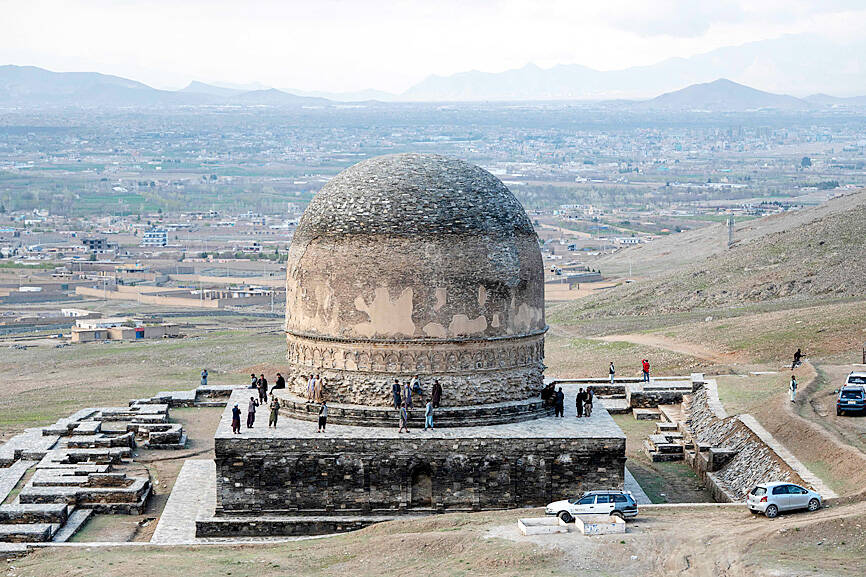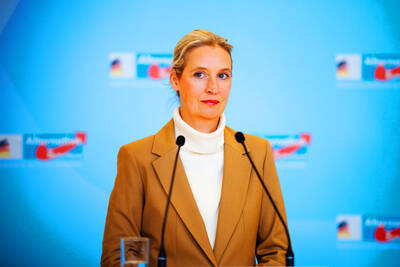In March 2001, the Taliban shocked the world by dynamiting the giant Buddhas of Bamiyan. Two decades later, they are back in power and claim to be making strides to preserve Afghanistan’s millennia-old heritage, including pre-Islamic relics.
Even months before their takeover in 2021 the Taliban called for the protection of ancient artifacts in the country, sparking skepticism among observers.
“All have an obligation to robustly protect, monitor and preserve these artifacts” and sites in Afghanistan, the Taliban authorities said in February that year.

Photo: AFP
They are “part of our country’s history, identity and rich culture,” they said.
Since their return to power and decades of war ended, archeological finds — particularly related to Buddhism — have proliferated, with discoveries publicized by the authorities.
In eastern Laghman Province, niches carved into rocks in Gowarjan Village are believed to have been storerooms dating back to the Kushan empire, which 2,000 years ago stretched from the Gobi Desert to the Ganges River.
Also in Laghman, carved Brahmi inscriptions have been found, along with a hollowed out stone slab used for pounding grapes for wine.
“It is said that Afghan history goes back 5,000 years — these ancient sites prove it; people lived here,” said Mohammed Yaqoub Ayoubi, head of the provincial culture and tourism department.
“Whether they were Muslim or not, they had a kingdom here,” he said, adding that the Taliban authorities afford “a great deal of attention” to the preservation of these sites.
In nearby Ghazni Province, information and culture head Hamidullah Nisar echoed the sentiment.
Recently uncovered Buddhist statuettes must be “protected and passed down to future generations, because they are part of our history,” he said.
These relics would have likely met a different fate during the Taliban’s first rule from 1996 to 2001.
Days after Taliban founder Mullah Omar ordered the destruction of all Buddhist statues to prevent idol worship, the gigantic 1,500-year-old Buddhas of central Bamiyan Province were pulverized — the Taliban having been unmoved by an international outcry.
“When they returned, people thought they would have no regard for historical sites,” said Mohammed Nadir Makhawar, director of heritage preservation in Laghman, a position he held under the ousted republic. “But we see that they value them.”
In December 2021, the Taliban reopened the Afghan National Museum, where they had once destroyed pre-Islamic artifacts.
The following year, they reached out to the Aga Khan Trust for Culture (AKTC) to help preserve the historic Buddhist site of Mes Aynak, where there is also a copper mine under a development contract with a Chinese consortium.
“The request was unexpected,” said Ajmal Maiwandi, the head of AKTC in Afghanistan, who even noted an “enthusiasm” from the authorities to support the conservation work.
“I think the Taliban have understood how much the destruction of the Bamiyan Buddhas damaged their reputation,” said Valery Freland, director of the foundation the International Alliance for the Protection of Heritage.
“They seem concerned today with preserving material heritage in all its diversity,” he added.
However, experts have highlighted that the Taliban authorities do not extend the same concern to intangible heritage: music, dance, folklore and anything involving women remain a red line in their severe interpretation of Islam.
And while a historic synagogue in the city of Herat was preserved after the Taliban takeover, local authorities have recently resisted media attention on the site and the city’s former Jewish community.
Afghanistan has signed several conventions on heritage since the Taliban’s first reign, with its destruction deemed a war crime in 2016.
Beyond the risk of angering the international community — whose recognition the Taliban seek — Afghanistan’s heritage represents “a potential lever for the country’s tourism and economic development,” an industry expert speaking on condition of anonymity said.
However, the authorities face two major challenges, the source said, pointing to a lack of financial resources and the departure — following their takeover — of “the archeological and heritage elite”.
Security could hamper tourism ambitions as well; a group visiting Bamiyan was targeted in a deadly militant attack last year.
In the tiny Laghman museum, a plastic bag and newspaper serve as protection for the statuettes, one of which depicts the face of a Buddhist goddess.
It was discovered last year in the courtyard of a farm, among milling cows and goats.
Ayoubi said he needs help to properly conserve and study them to determine their precise age, a process hampered by four decades of war in Afghanistan.
Looting has also proved an ongoing challenge, with no fewer than 30 sites still being “actively pillaged,” a 2023 study by University of Chicago researchers said.
Even if preservation projects have not been disrupted, Maiwandi remains “cautiously optimistic.”
“The situation in Afghanistan can change quickly,” he said.

A feud has broken out between the top leaders of the far-right Alternative for Germany (AfD) party on whether to maintain close ties with Russia. The AfD leader Alice Weidel this week slammed planned visits to Russia by some party lawmakers, while coleader Tino Chrupalla voiced a defense of Russian President Vladimir Putin. The unusual split comes at a time when mainstream politicians have accused the anti-immigration AfD of acting as stooges for the Kremlin and even spying for Russia. The row has also erupted in a year in which the AfD is flying high, often polling above the record 20 percent it

Ecuadorans are today to vote on whether to allow the return of foreign military bases and the drafting of a new constitution that could give the country’s president more power. Voters are to decide on the presence of foreign military bases, which have been banned on Ecuadoran soil since 2008. A “yes” vote would likely bring the return of the US military to the Manta air base on the Pacific coast — once a hub for US anti-drug operations. Other questions concern ending public funding for political parties, reducing the number of lawmakers and creating an elected body that would

The latest batch from convicted sex offender Jeffrey Epstein’s e-mails illustrates the extraordinary scope of his contacts with powerful people, ranging from a top Trump adviser to Britain’s ex-prince Andrew. The US House of Representatives is expected to vote this week on trying to force release of evidence gathered on Epstein by law enforcement over the years — including the identities of the men suspected of participating in his alleged sex trafficking ring. However, a slew of e-mails released this week have already opened new windows to the extent of Epstein’s network. These include multiple references to US President Donald

CHARGES: The former president, who maintains his innocence, was sentenced to 27 years and three months in prison for a failed coup bid, as well as an assassination plot Far-right former Brazilian president Jair Bolsonaro is running out of options to avoid prison, after judges on Friday rejected his appeal against a 27-year sentence for a botched coup bid. Bolsonaro lost the 2022 elections and was convicted in September for his efforts to prevent Brazlian President Luiz Inacio Lula da Silva from taking power after the polls. Prosecutors said the scheme — which included plans to assassinate Lula and a top Brazilian Supreme Court judge — failed only due to a lack of support from military top brass. A panel of Supreme Court judges weighing Bolsonaro’s appeal all voted to uphold